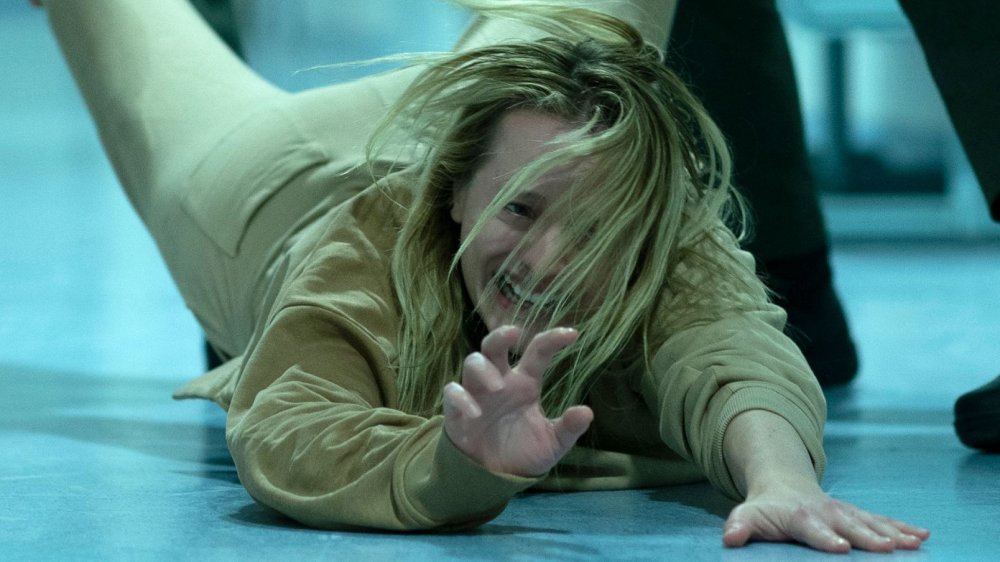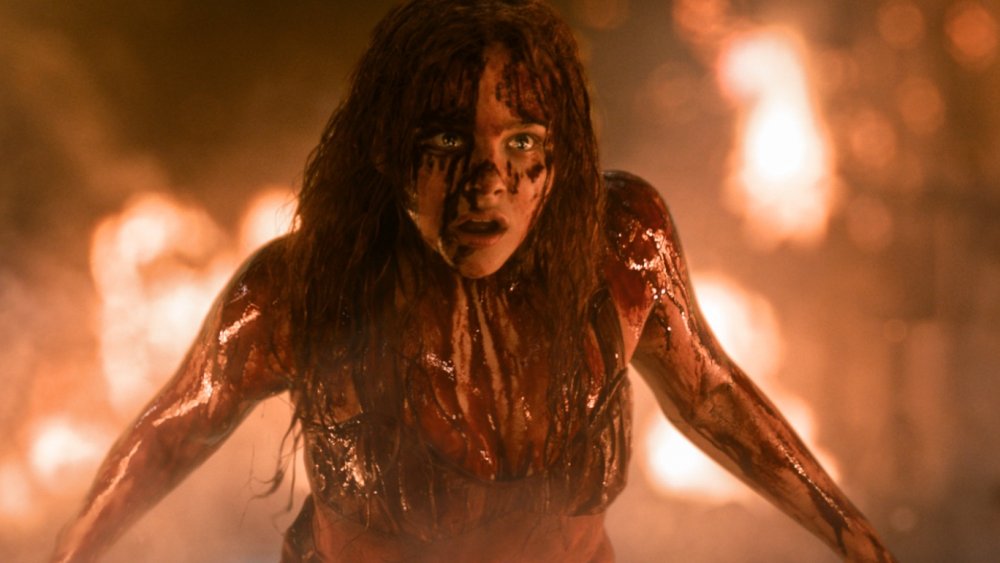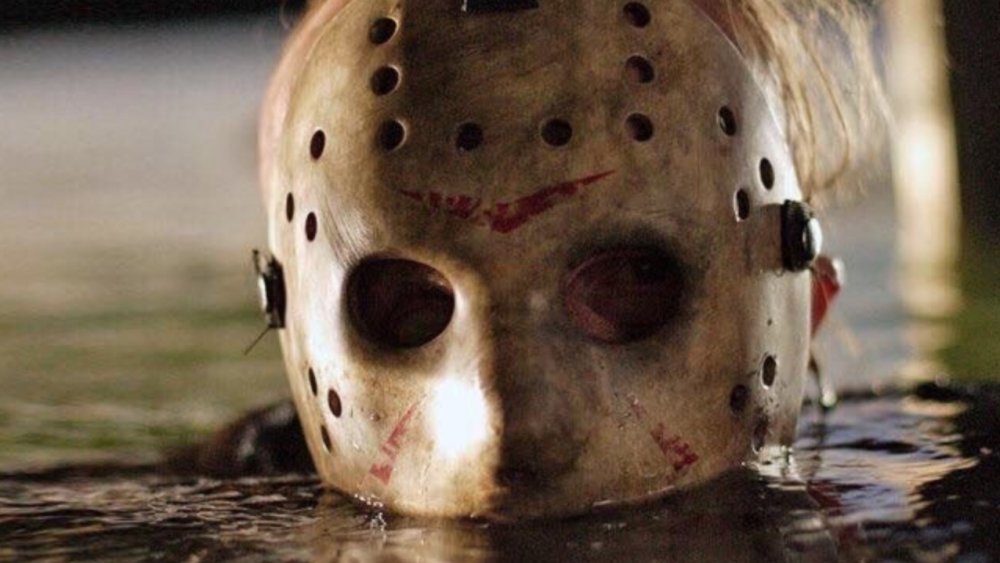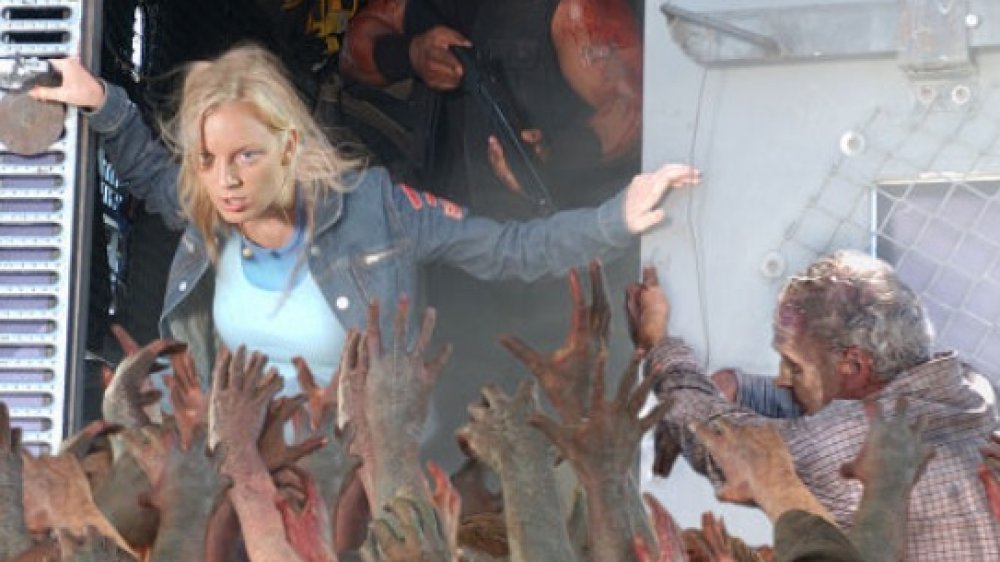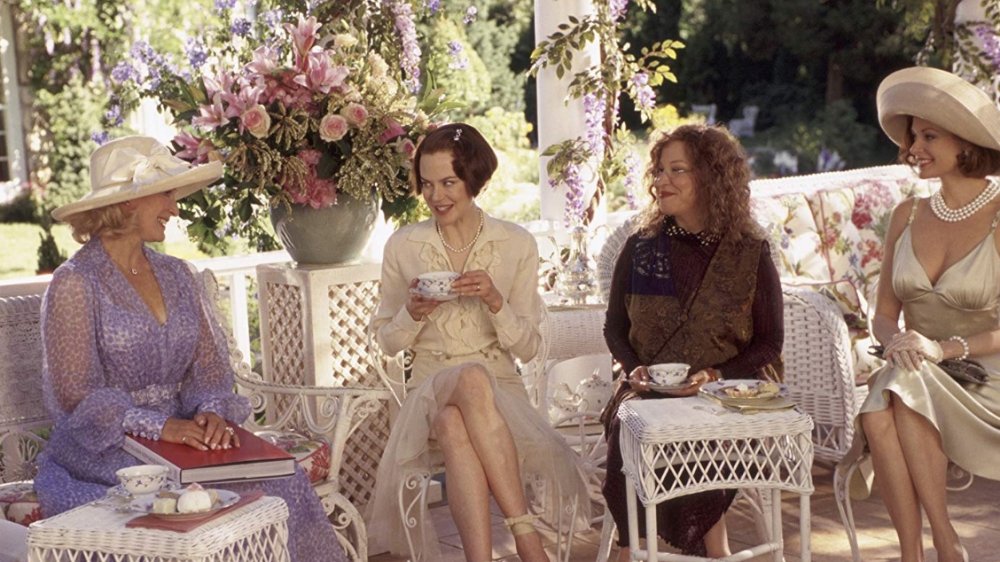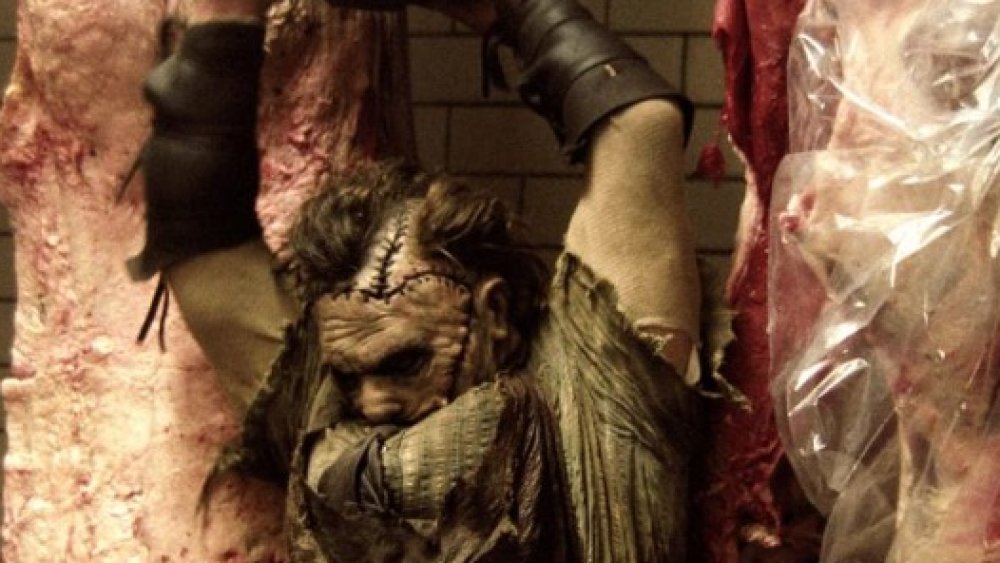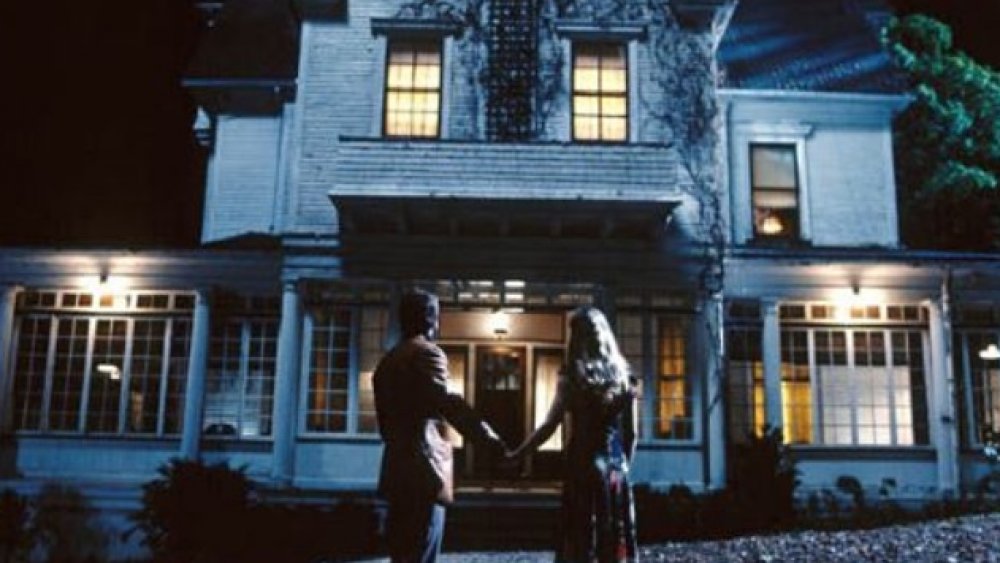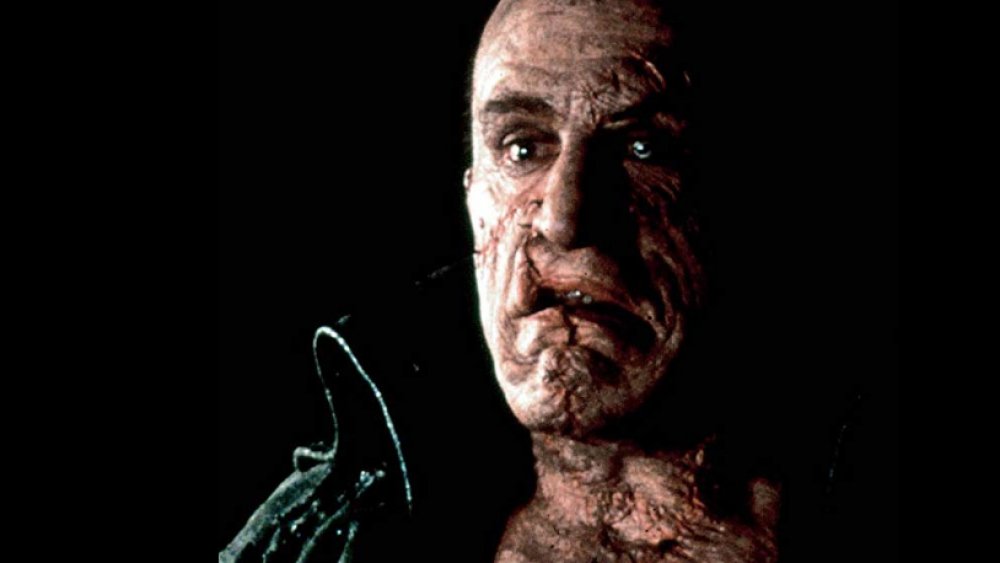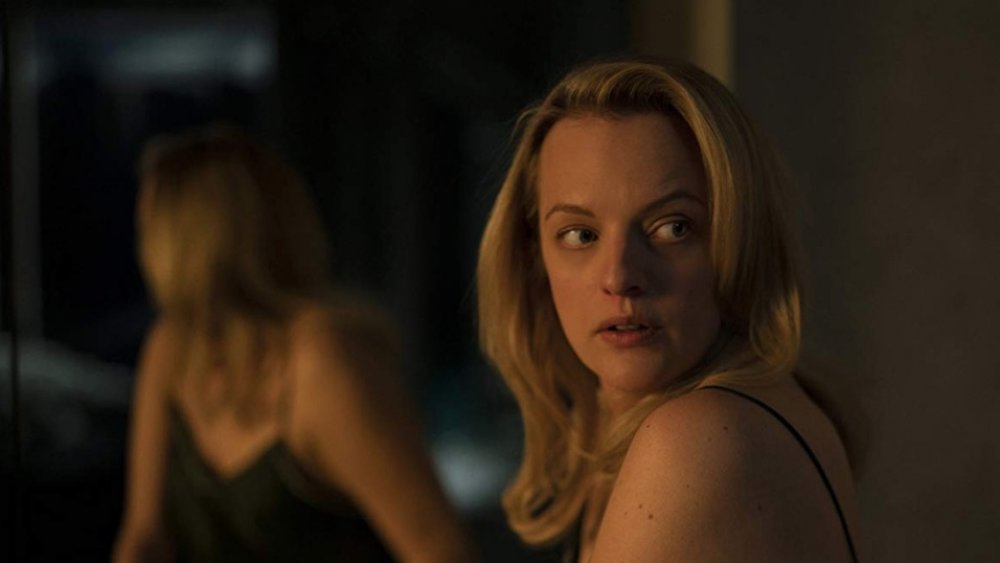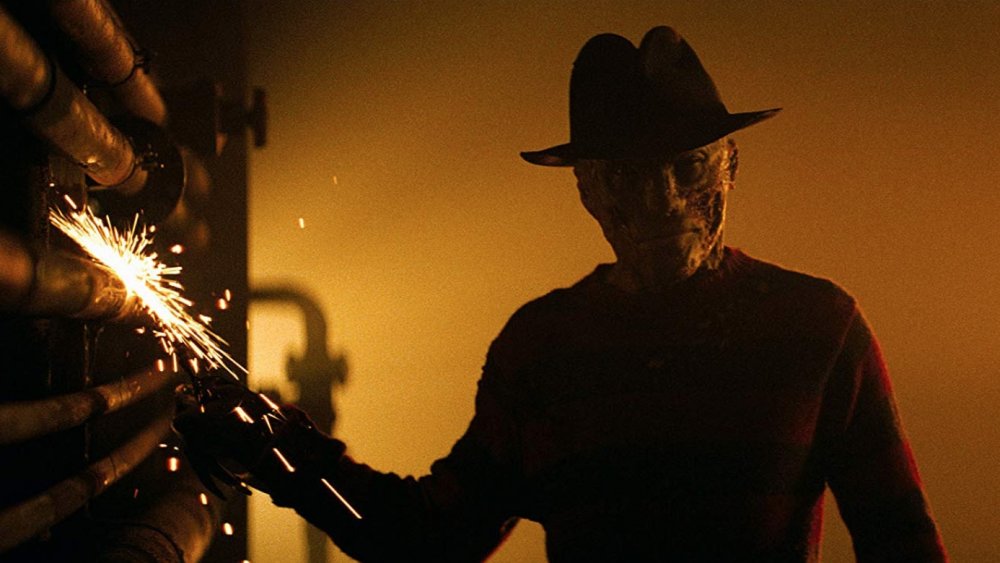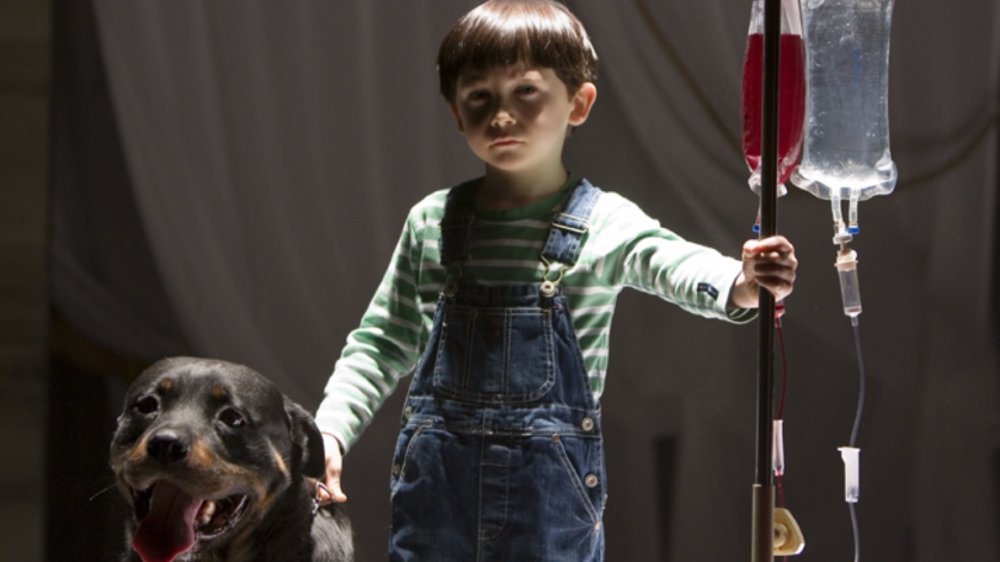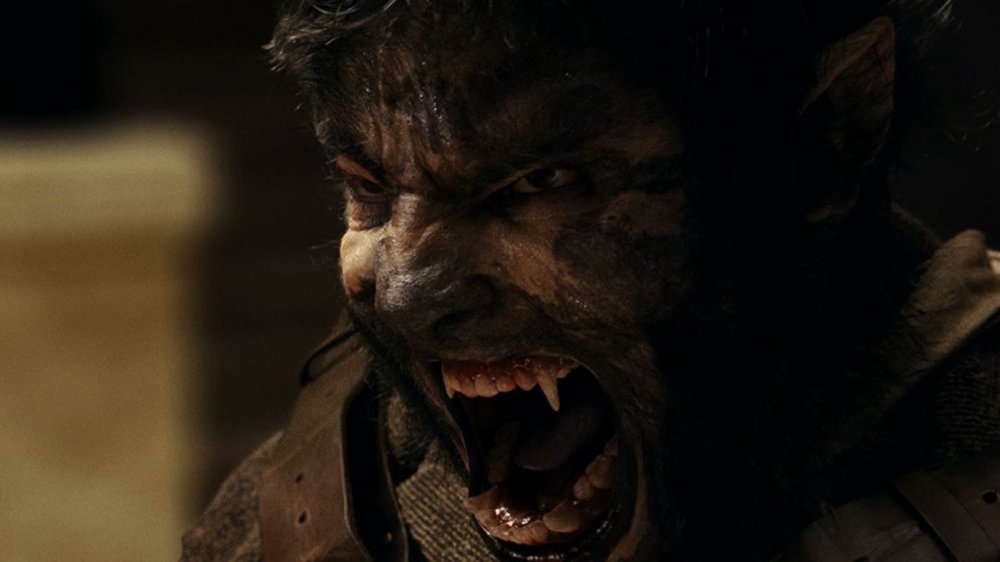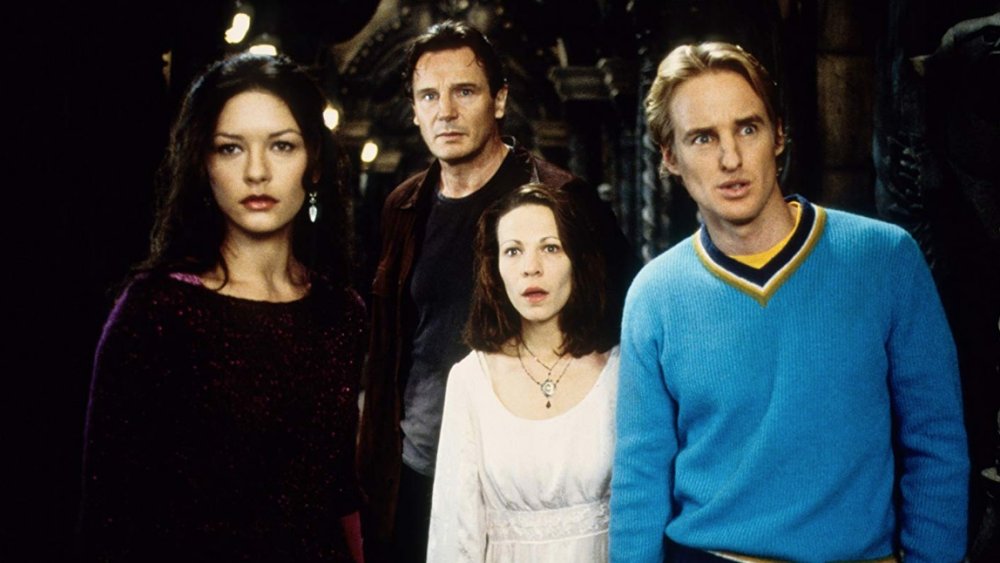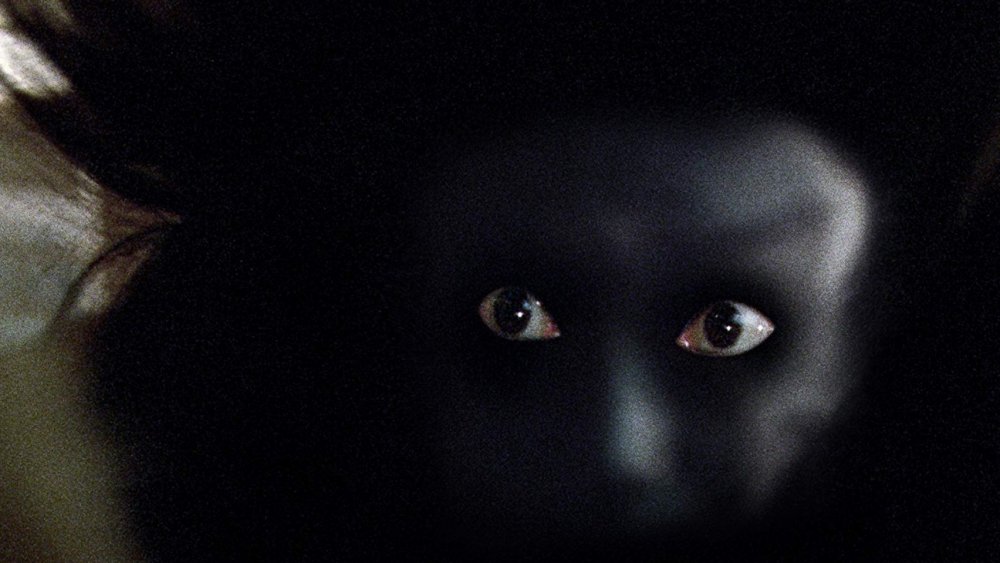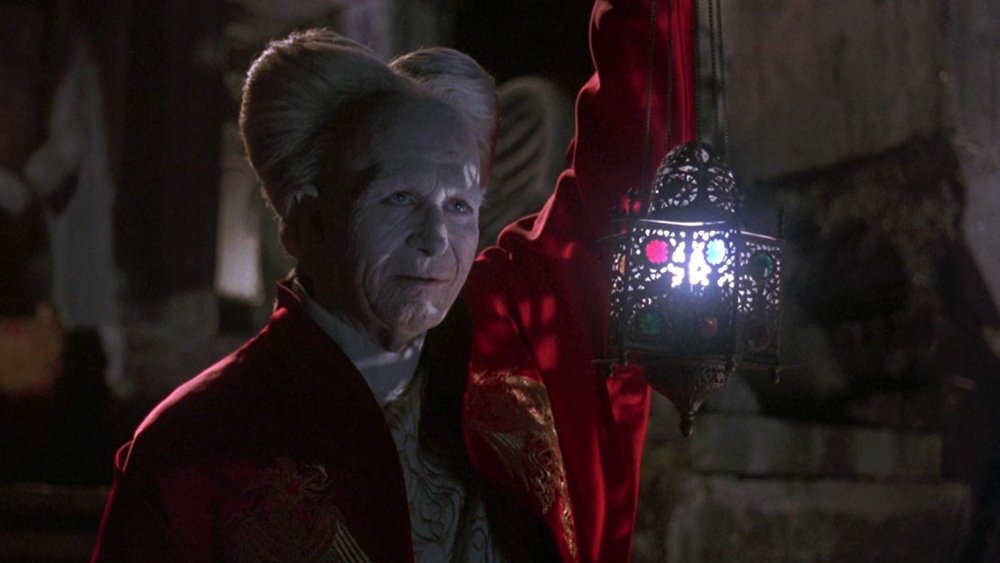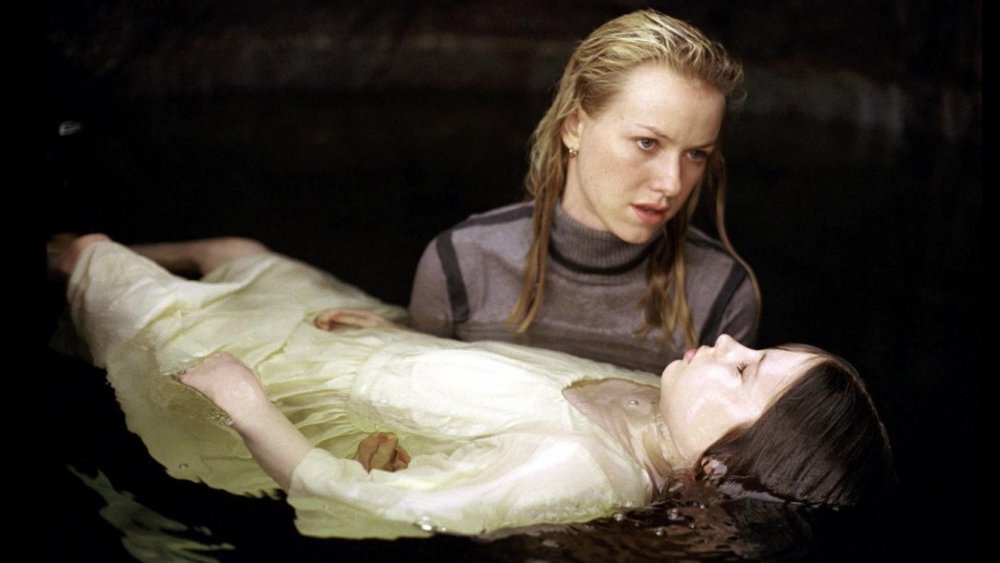The Highest-Grossing Horror Movie Remakes Of All Time
Horror movies kill at the box office, but not always for the reasons you might think. Creatures who go bump in the night don't break opening weekend records or top the all-time box office charts like movies from major brands like Marvel, DC, or Star Wars. Unlike those tentpole pictures, studios rarely invest a ton of capital into producing horror movies in the hopes of turning an even-more-massive profit. Horror movies are a triumph of economical moviemaking — or to put it more bluntly, they're cheap.
You can make a great horror movie for less than the catering budget on an Avengers film, and still rake in a ton of money at the box office and on home video, so it's no wonder that dollar-for-dollar, two of the most profitable movies of all time are horror films. It's a pretty great formula: cheap production budget plus built-in horror audience equals profit. What could be better? Well, turns out there is one thing — horror remakes. You take everything that makes a horror film so profitable, plus you decrease your risk even further by releasing a movie based on a popular, pre-existing intellectual property.
Hollywood Economics 101: if your franchise stops making money, just wait a few years and then remake or reboot it. It's flat-out frightening how successful some of these spooky movie remakes can be. Don't turn out the lights, because here are the highest-grossing horror movie remakes of all time.
Carrie was not another teen movie
Think your prom was awkward? Meet Carrie White. Hers involved getting covered in pig's blood and then setting the entire high school gymnasium on fire with her mind. So maybe not quite as awkward as pinning a corsage, but high school can be weird for everybody, right? Based on Stephen King's bestselling breakthrough horror novel, Carrie is about a shy, social misfit teenager who is bullied by mean girls, ignored by cool boys, and practically enslaved by her religious zealot mother. She also has to deal with having telekinetic powers, which she uses to wreak vengeance on the students who tormented and humiliated her.
The original version of the film made $33 million in 1976, roughly $149 million today. Pretty impressive, yeah? With numbers like that, it's surprising it took a Hollywood studio 23 years to make The Rage: Carrie 2, a loose sequel that bombed, earning $17 million worldwide on a $21 million budget. Numbers like that put your franchise in detention, but you just can't keep a good teenage witch down (ask Sabrina). A Carrie remake was released in 2013 and earned $35 million domestically and $84 million worldwide on a $30 million budget. Movie studio Screen Gems probably celebrated those numbers, though hopefully they didn't hire Carrie White to handle event planning.
13 is a lucky number for this famous franchise
It's named after a day of superstition, but Friday the 13th has been very fortunate at the box office. Everybody's favorite hockey mask-wearing, machete-wielding monster has earned a total of $382 million domestic and $466 million worldwide on a combined budget of $78.6 million, an average cost of $6.5 million per film for an average gross of $38 million worldwide. No wonder they made 12 of them, sending Jason to hell, space, and face to face with Freddy Krueger. The original Friday the 13th earned $39 million domestic, $59 million worldwide in 1980 on a budget of $550K. Despite two films in the franchise literally having "final" in the title — Part IV: The Final Chapter in 1984 and Jason Goes To Hell: The Final Friday in 1993 — Jason finally retired after the 2003 OG horror cinematic universe crossover, Freddy vs. Jason.
But just like any unstoppable killing machine should, Jason returned again. This time it was 2009's Friday The 13th, a franchise reboot that opened to a magnificent $40 million, a boffo opening weekend that doubled its $17 million budget and signaled the potential for a $100+ million domestic run. However, 2009's Friday The 13th sunk faster than, well, Jason Voorhees in Camp Crystal Lake (sorry, not sorry), though it still earned $65 million domestically and $92 million worldwide. It has been more than a decade since the last Jason movie, and frankly we're shocked he hasn't made a comeback... yet.
Zack Snyder's career was "Dead" on arrival
Before The Walking Dead slow-walked into cable TV history, zombie lovers went to the big screen for their brain-eating fixation, and nobody satisfied their craving better than the late George Romero. Romero practically invented the modern zombie movie genre in 1968's Night of the Living Dead, and made what many consider to be his masterpiece (and the greatest zombie movie ever) in 1979 with Dawn of the Dead. From a $1.5 million budget, Romero's Dawn of the Dead has earned a solid $5 million domestically and an astounding $55 million worldwide. In the movie, a group of survivors from the zombie apocalypse band together inside a mall, doing battle against an army of the undead, and each other.
The film's potent mix of horror and action still holds up today, but it's most memorable for its unsubtle critique of American consumerism. The scores of brain-dead zombies walking through a mall like mindless shoppers looks eerily familiar, even if shoppers today are more likely to shop online (An internet zombie movie? Make it happen, Hollywood!) Twenty-five years later a visionary young director named Zack Snyder brought Dawn of the Dead back to life, so to speak. Snyder's 2004 Dawn of the Dead remake made back its $26 million budget on its opening weekend, and ultimately earned $59 million domestic and $102 million worldwide. Snyder traded zombies for superheroes and cashed in on his newfound bankability from this film to make 300, Watchmen, and several DCEU films.
The Stepford Wives profits weren't domestic bliss
Based on the satirical 1972 thriller by Ira Levin, The Stepford Wives is a different kind of horror story. There are no zombies, demonic spirits, or knife-wielding super-predators. No, the villains of this film are middle-aged dudes who crack dad jokes and cold ones, wear grass-stained, white New Balance sneakers, and discuss propane vs. charcoal grillers. In the 1975 film, a young wife and mother moves to the quaint little town of Stepford, Connecticut with her family, but is taken aback by the all-too-perfect behavior of the female residents. With their picture-perfect looks, devotion to domestic duties, and "whatever you say, dear" submissive attitudes, the wives in Stepford make the models from a 1950s coffee print ad look like Gloria Steinem. Turns out the wives are actually robots, making this story like The Handmaid's Tale meets Westworld.
The Stepford Wives made a modest $4 million in 1975, but struck a nerve, as "Stepford Wife" is now a pop culture pejorative. The film was remade nearly 30 years later, this time as a half-comedy/half-horror hybrid, with a big budget ($90 million) and major movie stars (Nicole Kidman, Christopher Walken, Bette Midler, Glenn Close) attached. Audiences weren't any more impressed than they were in 1975. The Stepford Wives made $59 million domestic and $103 million worldwide. While The Stepford Wives bombed based on its budget, it is still technically one of the highest-grossing horror movie remakes ever.
Leatherface has earned plenty of greenbacks
The family that slays together, stays together. That has certainly proved to be the case with the clan at the center of The Texas Chain Saw Massacre franchise, which has made a combined $194 million domestic and $246 million worldwide across seven films on a total budget of $49 million. The average cost of a Massacre movie is $9 million and it brings in an average $27 million domestic and $35 million worldwide. However you slice it, even with Leatherface's chainsaw, those are solid numbers.
The 1974 original was super profitable, earning $26 million worldwide on a shockingly low $140K budget. The studio put the franchise to bed after the fourth film, Texas Chainsaw Massacre: The Next Generation, bombed big time in 1995. It earned less than $100,000 worldwide, but is worth watching for a pre-Jerry Maguire Renée Zellweger being terrorized by a pre-A Time To Kill Matthew McConaughey playing Leatherface's wacky relative Vilmer Slaughter. Producer Michael Bay brought the psycho band back together for The Texas Chainsaw Massacre remake in 2003 and it made bank, earning $80 million domestic and $107 million worldwide on a $9 million budget. This enormous success launched a second Texas Chainsaw Massacre franchise, which saw diminishing returns with 2006's prequel The Texas Chainsaw Massacre: The Beginning and Texas Chainsaw 3D in 2009. Hey, Leatherface may not be People's "Sexiest Man Alive," but the man is a bona fide movie star.
$pooky House = Major Profits!
Nothing puts butts in seats like ghosts in houses. For example: The Amityville Horror, in which a newlywed couple and their children move into a home that was the site of a grisly mass murder and are soon terrorized by demonic forces. Hopefully they got a good deal on Zillow (you just can't pass up a bargain). The 1979 original was a bona fide mega-hit, earning $86 million worldwide, about $305 million adjusted for inflation, and becoming the second highest-grossing movie of the year after Superman: The Movie (fun fact: Margot Kidder starred in both, making her one of the few actors to ever star in the two biggest hits in a single year). The series saw diminishing returns with Amityville II: The Possession in 1982 and Amityville 3-D in 1983, so the evil house was taken off the market for 22 years until its 2005 remake starring Ryan Reynolds. The haunted house flick was once again a hit, earning $65 million domestically and $109 million worldwide on an $18.5 million budget. Despite numbers like that, there wasn't a follow-up until 2017's Amityville: The Awakening, which flopped big time, making only $7 million worldwide. Talk about scary!
Mary Shelley's Frankenstein was not quite a monster smash
Based on the 1818 novel by Mary Shelley, Frankenstein: Or the Modern Prometheus is a gothic horror classic that filmmakers have brought to life since the beginning of cinema. The first was Edison Productions, which took tremendous liberties with Shelley's story in a 12-minute, 1910 silent version. Filmmakers would continue to put their own spin on Frankenstein's monster for decades to come.
The most famous version of the character was played by Boris Karloff in James Whale's 1931 classic, a cornerstone (or should we say tombstone?) of Universal Pictures' horror movie library. Film theorists could write a doctoral dissertation on all of the versions of Frankenstein that have been committed to film, including Frankenstein Conquers the World, a kaiju movie from Godzilla studio Toho in which a 60-foot tall Frankenstein battles a fire-breathing dinosaur. In 1994, famed Shakespearean actor and director Kenneth Branagh abandoned the Bard and instead set out to tell the most faithful rendition of the story, even going so far as to title his film Mary Shelley's Frankenstein. Naturally, Branagh took liberties with the story, but it paid off: With Robert De Niro headlining as the Monster, Mary Shelley's Frankenstein made $22 million domestic and $112 million worldwide on a $45 million budget. While hardly a blockbuster, it's still a pretty solid take, one that makes it one of the highest-grossing horror remakes ever.
The Invisible Man's success is easy to see
H.G. Wells' The Invisible Man is an 1897 novel about a scientist who creates a serum that turns him invisible, though his newfound abilities steadily drive him insane. The most famous version of the story was the 1933 film starring Claude Rains and directed by Frankenstein director James Whale. The Invisible Man has since become a staple of the Universal Pictures monster movie lineup and was one of the most influential special effects films of all time.
While The Invisible Man's popularity may be harder to see compared to his creature contemporaries Frankenstein, Dracula, and the Wolfman, the idea of a man who goes mad after turning invisible has been a mainstay in movies ever since, from Memoirs of an Invisible Man starring Chevy Chase to Hollow Man starring Kevin Bacon. In 2020, Universal flipped the script and no longer focused on the titular invisible man, but on his victim. The Invisible Man stars Elisabeth Moss as the abused ex of a tech billionaire who is left his fortune — but begins to suspect her husband didn't die, but simply vanished, literally, and is now tormenting her. Audiences dug this fresh take on an old classic as The Invisible Man opened to $28 million, four times its $7 million budget. With a box office cume that stands at more than $60 million domestic and $100 million worldwide, The Invisible Man represents a bold new vision for classic Universal horror.
Freddy's box office is a Nightmare come true
Freddy Krueger may have haunted his victim's nightmares, but he's been delivering the kind of profits that movie studios dream about since his debut in 1984's A Nightmare on Elm Street. For a combined cost of $101.8 million, the Freddy Krueger series has made $361 million domestically and $448 million worldwide across nine films, delivering an average box office gross of $49 million for a modest price of $11 million per film. The original Nightmare mustered $25 million worldwide on a $1 million budget, and kept star Robert Englund gainfully employed throughout the 1980s and early 1990s. Freddy Krueger took a nine-year hiatus after 1994's Wes Craven's New Nightmare before returning to do battle against fellow teenager-slayer Jason Voorhees in 2003's Freddy vs. Jason. And that was it for the Robert Englund Freddy Krueger series... but not for Freddy Krueger. Jackie Earle Haley donned the striped red sweater, tattered fedora, and clawed gloves in 2010's A Nightmare on Elm Street remake. It worked out pretty well, as the film cost a mere $35 million to produce, made $32 million its opening weekend, and finished its run with $63 million domestic and $117 million worldwide.
666 reasons The Omen was such a big hit
After the record-breaking results of The Exorcist in 1973, Hollywood figured that if the devil was big business at the box office, his son must be too. Hence The Omen, a 1976 psychological horror film that managed to snag major movie stars Gregory Peck and Lee Remick to play a diplomat and his wife who accidentally adopt Satan's son. Surely you can return a kid in that situation, right? Heads roll, literally, as different supporting characters try to stop the lil' devil, meeting outlandishly grisly fates straight out of a Final Destination film. The original The Omen earned $48 million in 1976 on a $2.8 million budget, making it one of the ten biggest hits of the year. Its two sequels — Damien: Omen II in 1978 and Omen III: The Final Conflict in 1981 — saw diminishing returns, but the series did something that horror movie franchises typically don't do — it stayed dead! For a while, anyway. Thirty years after the original, The Omen returned on June 6, 2006, or 6-6-06, leaving us to wonder if they made the movie solely to capitalize on that release date. The Omen earned $65 million domestically and $119 million worldwide on a $25 million budget. A movie that profitable usually launches a new series, but Satan's son never got another sequel, so maybe the devil truly was in the details.
The Wolfman's box office bark was worse than its bite
Remember, kids: just because your movie makes money doesn't mean it's profitable. Case in point: 2010's The Wolfman. Based on Universal's favorite lupine, The Wolfman starred Benicio del Toro, Anthony Hopkins, and Emily Blunt, and was directed by Joe Johnston, director of Jumanji and Captain America: The First Avenger. It had a great pedigree, but a ridiculous budget. It went into production costing $100 million, but that soon spiraled out of control, ballooning all the way up to $150 million. With a budget like that, the movie had to break records to break even. It didn't. The Wolfman opened to $31 million on its way to $61 million domestic and a $139 million worldwide gross — impressive numbers for a horror movie, but not one that had the budget of a summer blockbuster. Universal must have been feeling boffo about this not-so-good boy, as the Wolfman was one of the principal players from the studio's classic slate of horror films from the 1930s and 1940s, appearing in five films, and inspiring countless ripoffs. Alas, The Wolfman's box office was just ruff. While The Wolfman is one of the highest-grossing horror film remakes ever, the film's overblown budget makes it the biggest bomb on this list.
The Haunting spooks up millions
Shirley Jackson's 1959 gothic horror novel The Haunting of Hill House was a landmark in horror because it didn't rely on typical terror tropes, but instead focused on the psychology of its complicated characters. Her book has inspired two films, a play, and a Netflix TV series, each version taking numerous liberties with the story. The first was The Haunting, released in 1963, and directed by Robert Wise, a journeyman director most famous for The Day the Earth Stood Still, West Side Story, and The Sound of Music. It was a modest success, but wasn't nearly as profitable as Wise's biggest hits. Fast forward 36 years later to 1999. Jan De Bont, a few years removed from Speed and Twister, convinced Liam Neeson, Catherine Zeta Jones, and Owen Wilson to make a haunted house movie loosely based on Jackson's novel. With A-list talent like that, plus top-notch special effects, The Haunting's budget ballooned up to $80 million, roughly $124 million in today's dollars. It made back its budget, but barely, earning $91 million domestically and $177 million worldwide, a thin profit margin that spooked studios away from spending that much on a CG-heavy ghost story. The Haunting of Hill House was remade again in 2018, this time for Netflix. While the streamer doesn't release budgets or ratings, the show got huge buzz and will be getting a sequel, so we'd say it was pretty successful.
Moviegoers love holding a Grudge
The J-Horror craze captivated and creeped out American moviegoers in the early 2000s, with a host of American remakes based on Japanese originals. Few were more popular than The Grudge.
The Grudge stars Sarah Michelle Gellar as an American nurse living in Tokyo who is exposed to a supernatural curse that plunges people into a deep rage before taking their lives. So kinda like the gamma ray bursts that turned Bruce Banner into the Hulk, but fatal. The 2004 American remake was directed by Takashi Shimizu, who directed the 2002 Japanese original, Ju-on: The Grudge. Ju-on: The Grudge made waves in its native Japan and was picked up for worldwide distribution by Vitagraph Films, earning $3.6 million globally — not bad considering most foreign horror movies wind up going straight to DVD.
Ju-on: The Grudge launched a franchise in its homeland, including 2003's Ju-on: The Grudge 2, 2009's Ju-on: White Ghost, and 2015's Ju-on: The Final Curse. But the series' greatest success came with its American remake. On a budget of just $10 million, The Grudge opened to $39 million, earning $110 million domestically and $187 million worldwide. The film was remade again in 2020 and while it didn't reach the same heights as its predecessor, it still earned $21 million domestic and $48 million worldwide on a $10 million budget. When it comes to making money, The Grudge series is anything but cursed.
Bram Stoker's Dracula was a bloody blockbuster
Based on the 1897 novel by Bram Stoker, Dracula has been a motion picture mainstay for decades. Much like Frankenstein, the Count's big screen appearances are all but impossible to count, with so many sequels, spinoffs, remakes and ripoffs it'll drive you batty. Dracula was first committed to film in the copyright-infringing 1922 silent German expressionist film, Nosferatu. The most famous version arrived nine years later in 1931's Dracula, the Bela Lugosi film that launched the Universal horror series and established our shared pop cultural perception of the most famous vampire.
While iconic, this version of the character was a far cry from Stoker's original, and became a victim of its own success. The Universal Dracula had been parodied by everything from breakfast cereals to Sesame Street, so much so it has ceased to strike fear in viewer's minds. Francis Ford Coppola sought to change that and showed off how authentic his film was by titling it Bram Stoker's Dracula. Of course, this version took liberties too, and Bram Stoker's Dracula wound up looking more like Francis Ford Coppola's Dracula. While the film is best remembered for Keanu Reeves being woefully miscast as a British barrister Jonathan Harker, it was a huge hit in 1992. Bram Stoker's Dracula opened to $30 million, earning $82 million domestically and $215 worldwide on a $40 million budget. While Reeves' performance bites, this vampire flick's box office results definitely do not suck.
Creepy kid leads to a well full of cash
The J-Horror craze that defined horror in the pre-torture porn early 2000s was kicked off by its biggest hit — The Ring. The Ring is about people who die one week after watching a cursed video tape featuring a ring, hence the film's tagline: "Before you die you see the ring." While the original 1998 Ringu was successful in Japan, the film's international release resulted in an underwhelming $59,000 gross. Its sequel, 1999's Ringu 2, didn't do much better, earning $65,586 internationally. Still DreamWorks saw something in the story and took a chance on it with a $48 million budget. The gamble paid off. The Ring opened in 2002 to $15 million, but thanks to word-of-mouth, legged it out to a $129 million domestic and $249 million worldwide gross. Its 2005 sequel earned $76 million domestically and $163 million worldwide — much less, but nothing to sneeze out. The 2017 pseudo-sequel/reboot Rings showed there was still life left in this undead franchise, earning $27 million domestic and $83 million worldwide on a $25 million budget. Impressive numbers, but nothing can match the original The Ring, the highest-grossing horror movie remake of all time.
